As one of the largest predators to have ever lived, megalodon captures people’s imagination – and for good reason. But was this apex predator simply a beefed-up great white shark, and is it still lurking in the dark depths of the ocean?
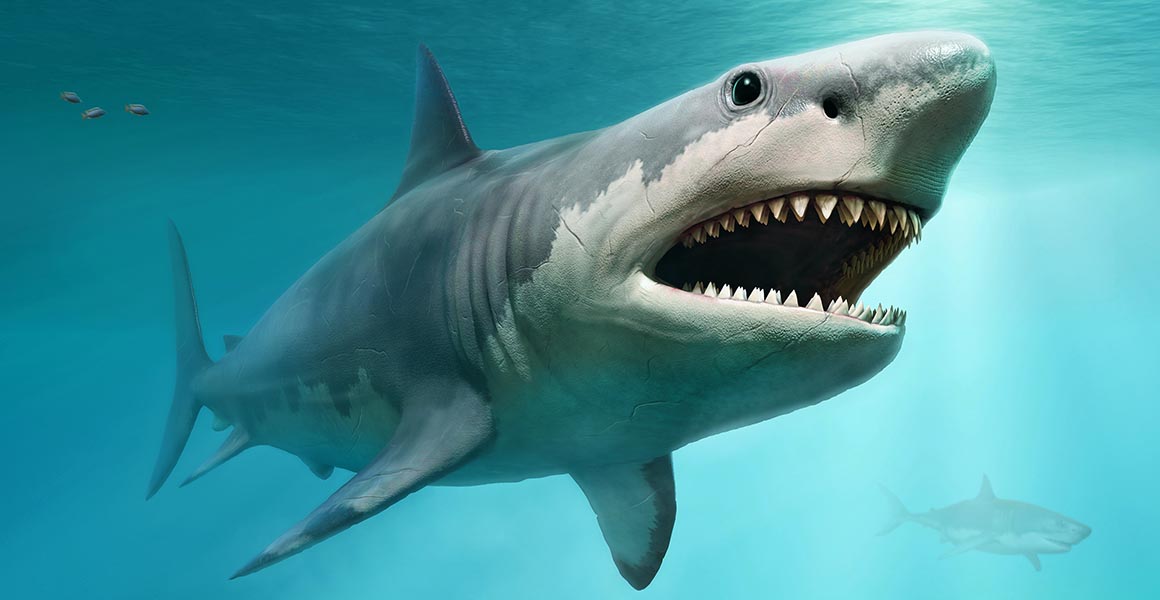
Megalodon has often been pictured as looking like a giant great white shark, but this is now thought to be inaccurate. In reality, it may have been a much slenderer shark. ©warpaint/Shutterstock
Emma Bernard, who curates the Natural History Museum’s fossil fish collection – including fossil sharks – helps separate fact from fiction.
How big is a megalodon?
The earliest megalodon fossils – Otodus megalodon, previously known as Carcharodon or Carcharocles megalodon – date to 23 million years ago. For nearly 20 million years the enormous shark dominated the oceans until becoming extinct just 3.6 million years ago.
O. megalodon was not only the biggest shark in the world, but one of the largest fish ever to exist.
A 2025 study, written by 29 fossil shark experts, found that megalodon may have grown up to 24.3 metres long. That makes it about four times longer than the largest recorded great white shark and a few metres longer than today’s biggest whale sharks, the largest of which has measured in at 18.8 metres. This massive measurement makes megalodon only a metre shorter than Hope, the blue whale suspended in our Hintze Hall.
A shark this size may have weighed up to 94 tonnes and cruised through the oceans at up to 3.5 kilometres per hour. This study also suggests that at birth, baby megalodons may have been up to 3.9 metres long.
No one has ever found complete megalodon skeleton, so previous body length estimates have been based on tooth size. These suggest a maximum length of 15–18 metres. Megalodon teeth can reach 18 centimetres long. In fact, the word megalodon simply means ‘large tooth’. These teeth can tell us a lot, such as what these massive animals ate.
Our fossil fish expert Emma Bernard explains how to calculate the length of megalodon using its teeth. Video with audio description (2 minutes 7 seconds).
However, to calculate a 24.3 metre megalodon, scientists have used a new method, studying nearly complete and partial megalodon vertebral columns found in Belgium and Denmark. These were then looked at in comparison to 170 species of living and extinct sharks, helping to work out head and tail fin sizes.
Research from 2022 suggests that megalodon’s size may have been affected by where it lived, with those in colder water growing to larger sizes.
What did megalodon eat?
“With its large serrated teeth megalodon would have eaten meat – most likely whales and large fish, and probably other sharks. If you are that big you need to eat a lot of food, so large prey is required,” Emma explains.
This would have included animals as small as dolphins and as large as humpback whales.
We have other evidence of megalodon’s feeding habits in the form of fossilised whale bones. Some of these have been found with the cut marks of megalodon teeth etched in the surface. Others even include the tips of teeth broken off in the bone during a feeding frenzy that occurred millions of years ago.
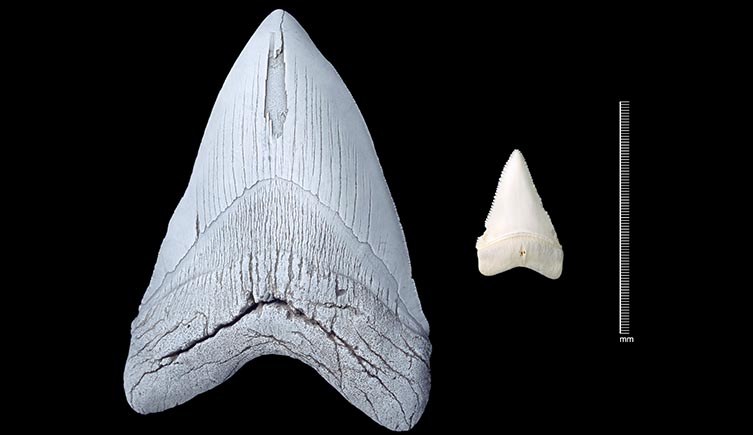
A megalodon tooth next to a tooth of a great white shark. The largest megalodon tooth ever found is almost 18 centimetres long. By comparison, great white teeth are usually about five centimetres long.
Megalodon jaws
In order to tackle prey as large as whales, megalodon had to be able to open its mouth wide. It’s estimated that its jaw would span 2.7 by 3.4 metres wide. That’s easily big enough to swallow two adult people side-by-side, or a London taxi cab.
These jaws were lined with 276 teeth, and studies reconstructing the shark’s bite force suggest that it may have been one of the most powerful predators ever to have existed.
Humans have been measured with a bite force of around 1,317 Newtons (N), while great white sharks have been predicted to be able to bite down with a force of 18,216N. Researchers have estimated that megalodon had a bite of between 108,514 and 182,201N.
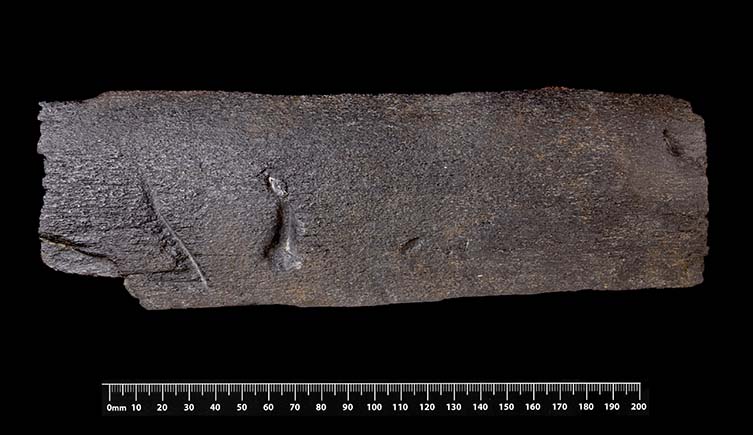
The tip of a megalodon tooth is preserved in this fossil whale rib bone.
What did megalodon look like?
Most reconstructions show megalodon looking like an enormous great white shark, Carcharodon carcharias. This is now believed to be incorrect.
Scientists have found that if you scaled a great white up to megalodon’s size, this animal would likely have trouble swimming. Instead, they suggest that megalodon may have had a much slenderer body, possibly with proportions like a lemon shark, making it more efficient in the water. O. megalodon also likely had a much shorter nose, or rostrum, when compared with the great white, with a flatter, almost squashed jaw. It also had extra-long pectoral fins to support its weight and size.
“A lot of reconstructions have megalodon looking like a bigger version of the great white shark because for a long time people thought they were related,” explains Emma. “We now know that this is not the case, and megalodon is actually from a different lineage of shark of which it was the last member.”
The oldest definitive ancestor of megalodon is a 55-million-year-old shark known as Otodus obliquus, which grew to around 10 metres in length. But the evolutionary history of this shark is thought to stretch back to a species of Cretalamna dating back 105 million years – making the lineage of megalodon over 100 million years old.
“As we’ve found more and more fossils, we’ve realised that the ancestor to the great white shark lived alongside megalodon. Some scientists think they might even have been in competition with each other,” says Emma..
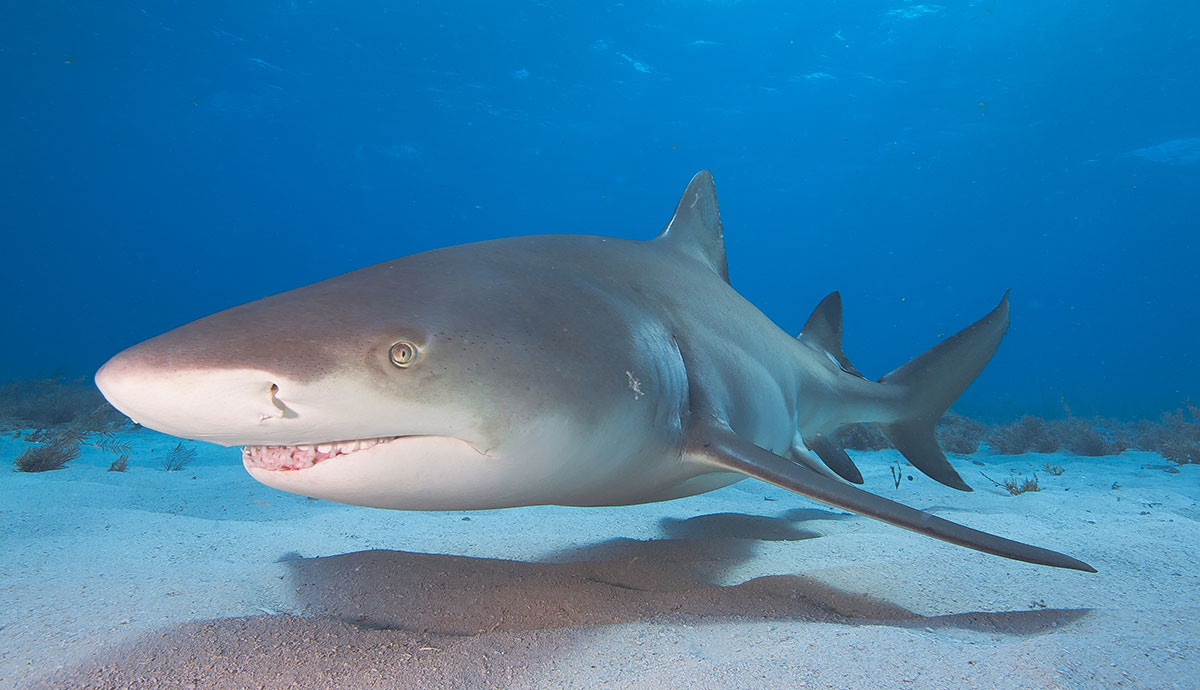
Megalodon may have had proportions similar to a modern lemon shark. © frantisekhojdysz /Shutterstock
Where did the megalodon live?
O. megalodon was adapted to warm tropical and subtropical locations around the globe. The species was so widely spread that megalodon teeth have been found on every continent except Antarctica.
“We can find lots of their teeth off the east coast of North America, along the coasts and at the bottom of saltwater creeks and rivers of North Carolina, South Carolina and Florida,” explains Emma. This is likely due in part to the age of the rocks, but also because they can easily be found on the sea floor allowing collectors to go diving for them.
“They are also quite common off the coast of Morocco and parts of Australia. They can even be found in the UK near Walton-on-the-Naze, Essex,” says Emma, although they are extremely rare in the UK and tend to be of poor quality.
Are megalodon teeth rare?
Almost all fossil remains of megalodon are teeth.
Sharks continually produce teeth throughout their entire lives. Depending on what they eat, sharks lose a set of teeth every one to two weeks, getting through up to 40,000 teeth in their lifetime. This means that shark teeth are continuously raining down onto the ocean floor, increasing the chance that they will get fossilised.
Teeth are also the hardest part of a shark’s skeleton. While our bones are coated in the mineral calcium phosphate, shark skeletons are made entirely from softer cartilage like our nose and ears.
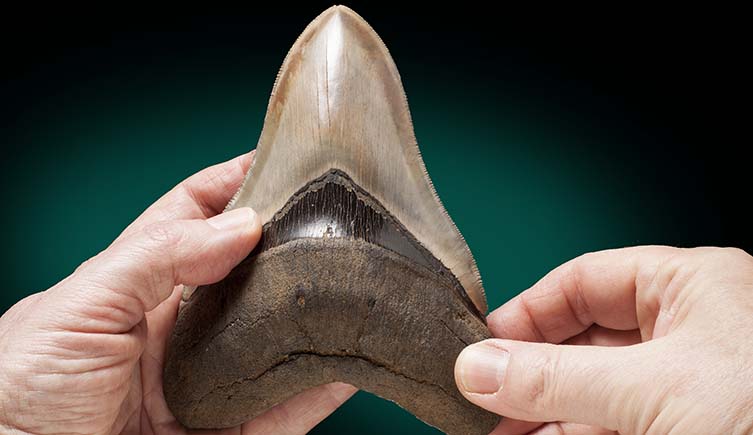
Megalodon teeth have been found on every continent except Antarctica. In the UK, Otodus megalodon teeth can occasionally be found washed out of the Red Crag, one of the younger rocks in East Anglia.
So, while the more robust teeth become fossilised relatively easily, only in very special circumstances will soft tissue be preserved.
Fossilised megalodon vertebrae about the size of a dinner plate have also been found.
“There was also a megalodon skull found in Peru that apparently has a crushed braincase and all the teeth, with a small string of vertebrae,” says Emma, “although I have yet to see high-quality images of this specimen.”
This extraordinary fossil may help create a better picture of what these gigantic predators looked like.
Why did megalodon go extinct?
We know that megalodon had become extinct by the end of the Pliocene, 2.6 million years ago, when the planet entered a phase of global cooling. Precisely when the last megalodon died is not known, but new evidence from the USA suggests that it was at least 3.6 million years ago.
Scientists think that up to a third of all large marine animals, including 43% of turtles and 35% of sea birds, became extinct as temperatures cooled and the number of organisms at the base of the food chain plummeted, resulting in a knock-on effect to the predators at the top.
The cooling of the planet may have contributed to the extinction of the megalodon in a number of ways.
As the adult sharks were dependent on tropical waters, the drop in ocean temperatures likely resulted in a significant loss of habitat. It may also have resulted in the megalodon’s prey either going extinct or adapting to the cooler waters and moving to where the sharks could not follow.

Great white sharks are largely misunderstood animals. © wildestanimal/Shutterstock
Megalodon is also thought to have given birth to its young close to the shore. These shallow coastal waters would have provided a nursery for the pups, protecting them from predators that were lurking in the open water, like the larger toothed whales. As ice formed at the poles and the sea level dropped, these pupping grounds would have been destroyed.
A study from 2022 suggests that competition with great white sharks for food may also have contributed to megalodon’s downfall. Studies of fossilised megalodon and great white teeth show that their diets overlapped.
Is the megalodon still alive?
“No. It’s definitely not alive in the deep oceans, despite what the Discovery Channel has said in the past,” notes Emma.
“If an animal as big as megalodon still lived in the oceans we would know about it.”
The sharks would leave telltale bite marks on other large marine animals, and their huge teeth would continue littering the ocean floors in their tens of thousands. Not to mention that as a warm-water species, it wouldn’t be able to survive in the cold waters of the deep, where it would have a better chance of going unnoticed.
Ask our scientists
Do you have a burning question about science or nature you want answered? Fill out the form below and we'll work with our scientists to answer some of them in our online magazine Discover or on our YouTube channel.
This new feature is in beta. Find out more.
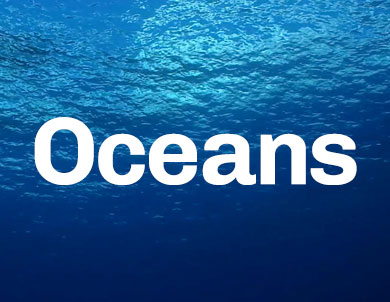
Discover oceans
Find out why we need to protect the oceans and read about the pioneering work of the Museum's marine scientists.
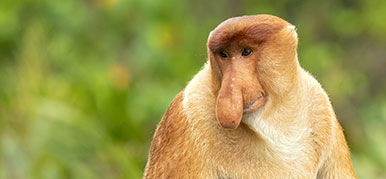
What on Earth?
Just how weird can the natural world be?
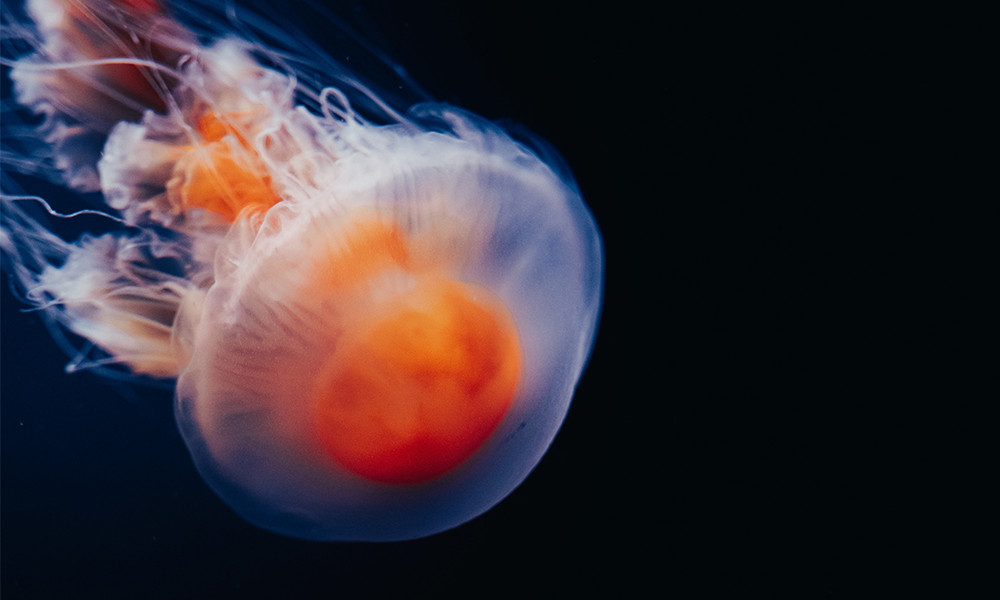
Sorry to surface...
But are you a deep-sea enthusiast? Explore the inky depths in our expert-led, online and on-demand course Deep Sea, available now.
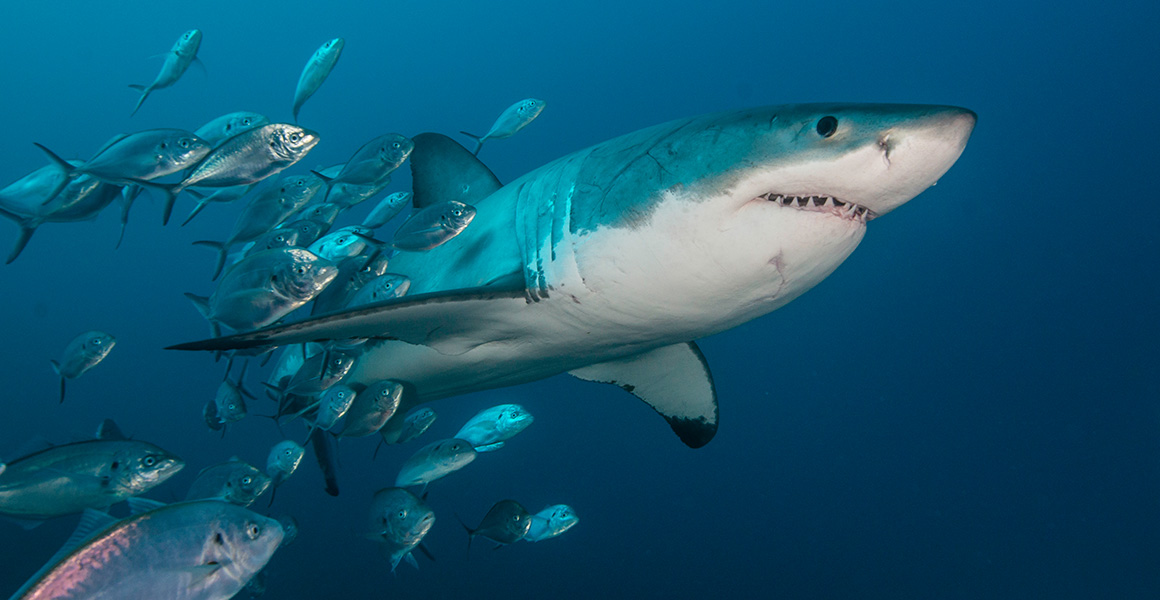
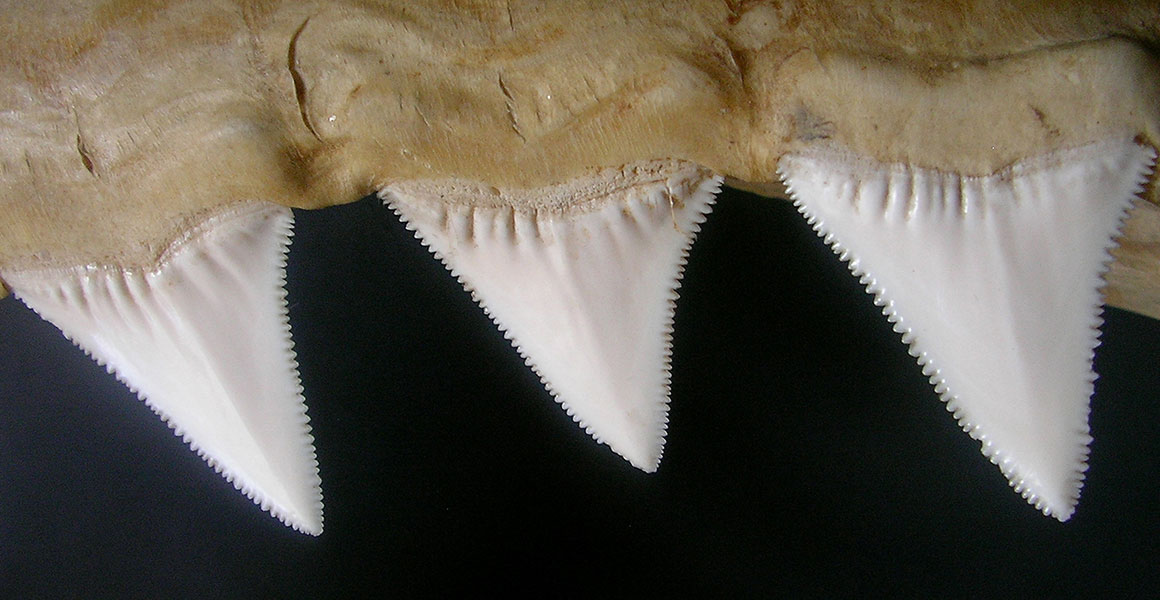
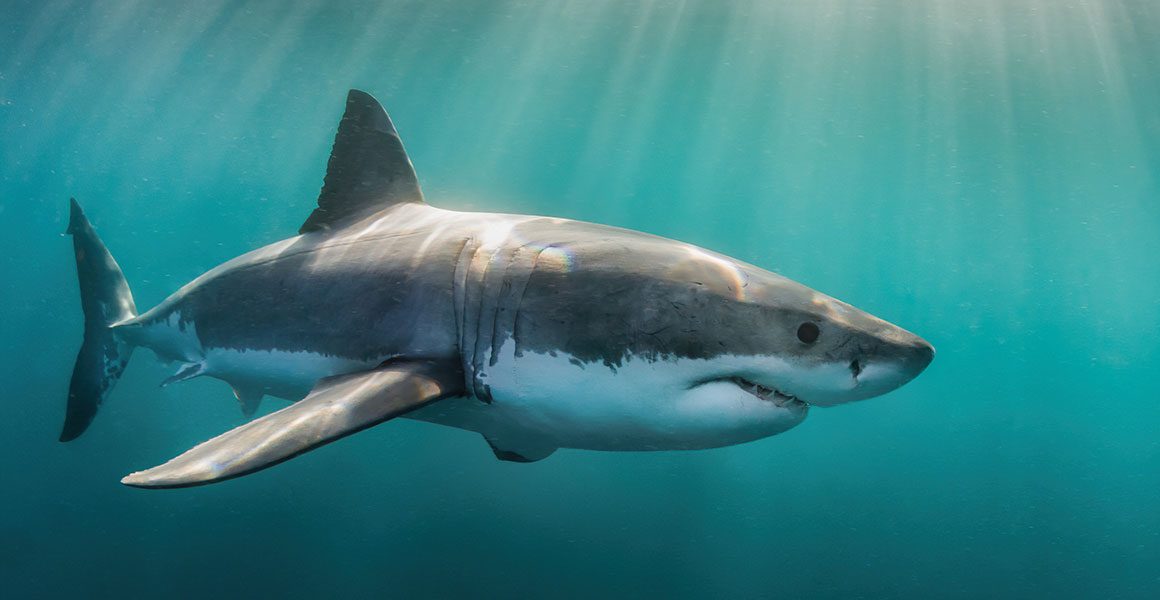
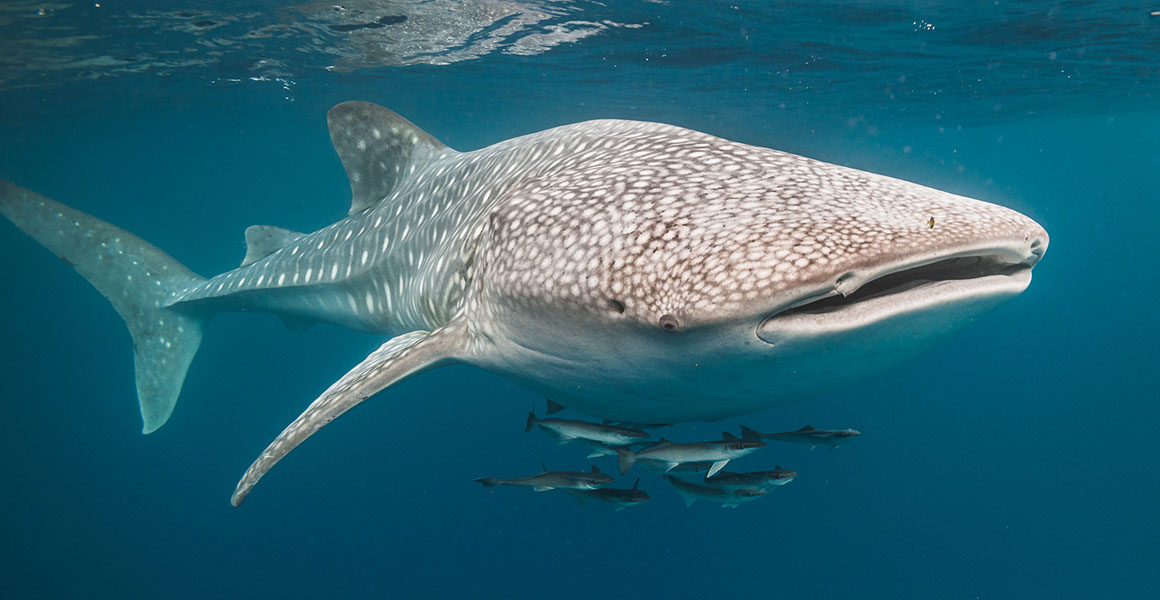
Don't miss a thing
Receive email updates about our news, science, exhibitions, events, products, services and fundraising activities. We may occasionally include third-party content from our corporate partners and other museums. We will not share your personal details with these third parties. You must be over the age of 13. Privacy notice.
Follow us on social media